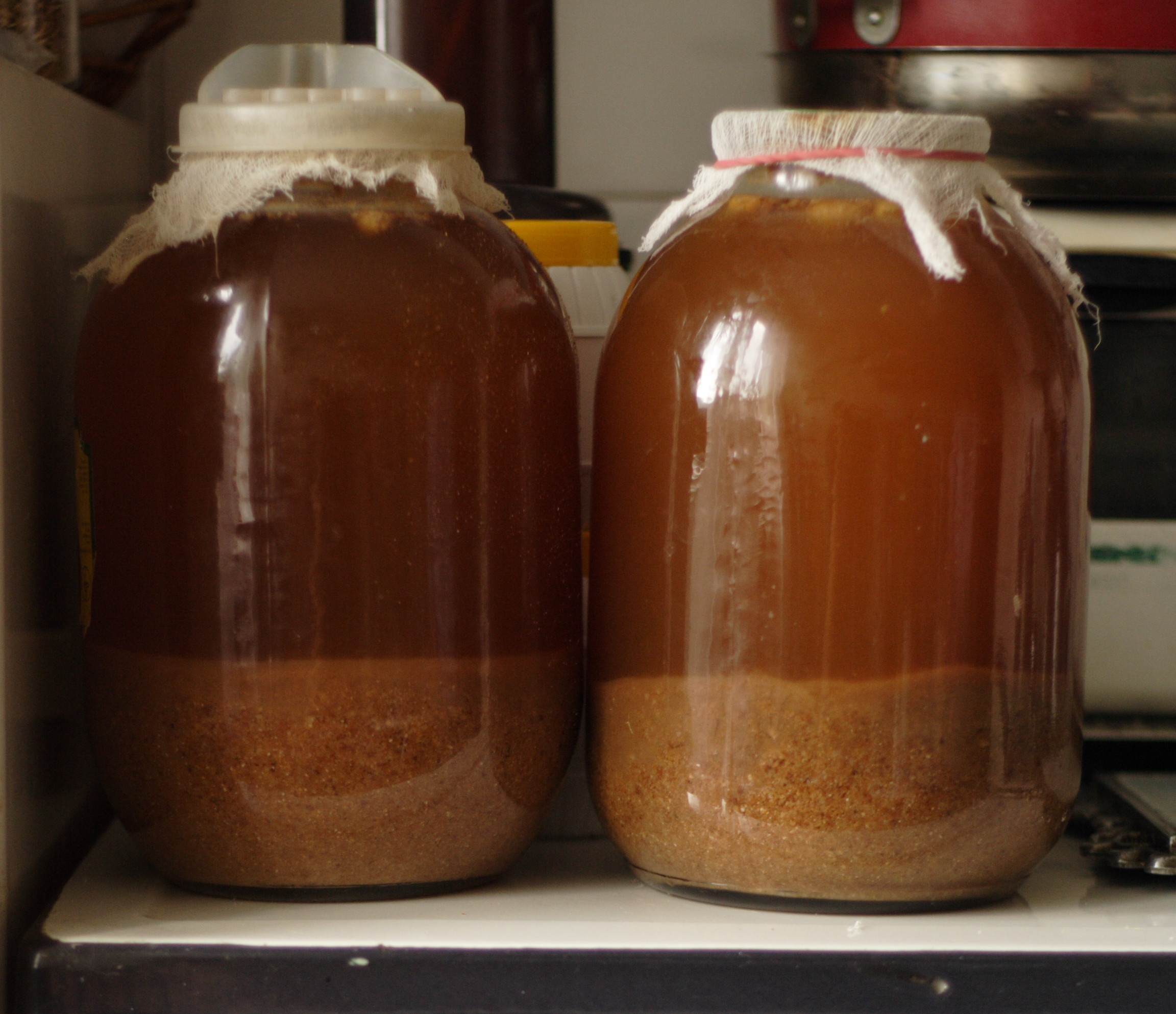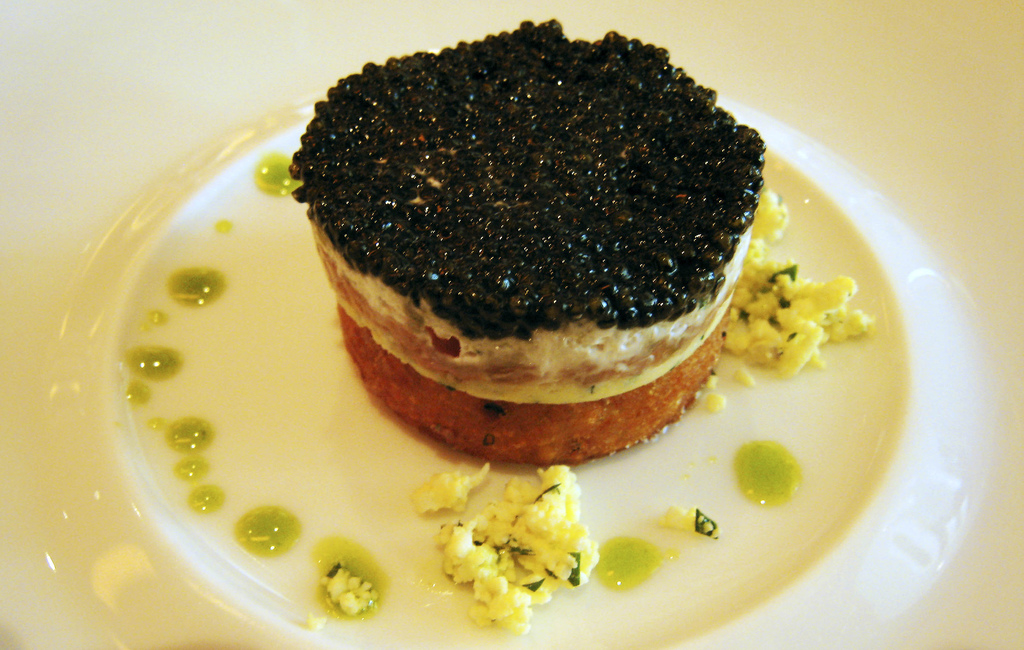|
Okroshka
Okróshka (russian: окро́шка) is a cold soup of Russian origin and probably originated in the Volga region. The classic soup is a mix of mostly raw vegetables (like cucumbers, radishes and spring onions), boiled potatoes, eggs, cooked meat such as beef, veal, sausages or ham and kvass, which is a low-alcoholic (1.5% or less) beverage made from fermented black or rye bread. Okroshka is usually garnished with sour cream ( smetana). Later versions that first appeared in Soviet times use light or diluted kefir, whey, ayran, or mineral water instead of kvass. The ingredients are diced and then mixed with kvass just before eating; the ratio of chopped food to kvass is similar to that of cereal to milk. This allows the vegetables to retain their texture. For that same reason, even though the ingredients are similar to those in a Russian salad, the taste of okroshka is quite different from that of the salad. Okroshka is mostly served in summer because the soup combines the ref ... [...More Info...] [...Related Items...] OR: [Wikipedia] [Google] [Baidu] |
Russian Cuisine
Russian cuisine is a collection of the different dishes and cooking traditions of the Russian people as well as a list of culinary products popular in Russia, with most names being known since pre-Soviet times, coming from all kinds of social circles. History The history of Russian cuisine was divided in four groups: Old Russian cuisine (ninth to sixteenth century), Old Moscow cuisine (seventeenth century), the cuisine that existed during the ruling of Peter and Catherine the Great (eighteenth century), and finally Petersburg cuisine, which took place from the end of the eighteenth century to the 1860s. In the Old Russian period, the main food groups were bread, lots of grains, and lots of foods that contained starch. Women baked pies with lots of different fillings, such as mushrooms or berries. During gatherings, a loaf of bread and salt was always present. Kasha, such as buckwheat, oats, etc.were represented as wellbeing to the household. Lots of Russians used honey and ... [...More Info...] [...Related Items...] OR: [Wikipedia] [Google] [Baidu] |
Kvass
Kvass is a fermented cereal-based Alcohol by volume, low alcoholic beverage with a slightly cloudy appearance, light-brown colour and sweet-sour taste. It may be flavoured with berries, fruits, herbs or honey. Kvass stems from the northeastern part of Europe, where the grain production is thought to have been insufficient for beer to become a daily drink. The first written mention of kvass is found in the ''Primary Chronicle'', describing the celebration of Vladimir the Great's baptism in 996. In the traditional method, kvass is made from a mash obtained from rye bread or rye flour and malt soaked in hot water, fermented for about 12 hours with the help of sugar and bread yeast or baker's yeast at a room temperature. In industrial methods, kvass is produced from wort concentrate combined with various grain mixtures. It is a popular drink in Russia, Ukraine, Poland, Baltic countries, Finland and some parts of China. Terminology The word ''kvass'' is ultimately from Proto-Indo-Eu ... [...More Info...] [...Related Items...] OR: [Wikipedia] [Google] [Baidu] |
List Of Soups
This is a list of notable soups. Soups have been made since Ancient history, ancient times. Some soups are served with large chunks of meat or vegetables left in the liquid, while others are served as a broth. A broth is a flavored liquid usually derived from boiling a type of meat with bone, a spice mix, or a vegetable mix for a period of time in a Stock (food), stock. A potage is a category of thick soups, stews, or porridges, in some of which meat and vegetables are boiled together with water until they form a thick mush. Bisque (food), Bisques are heavy cream soups traditionally prepared with shellfish, but can be made with any type of seafood or other base ingredients. Cream soups are dairy based soups. Although they may be consumed on their own, or with a meal, the canned, condensed form of cream soup is sometimes used as a quick sauce in a variety of meat and pasta convenience food dishes, such as casseroles. Similar to bisques, chowders are thick soups usually containi ... [...More Info...] [...Related Items...] OR: [Wikipedia] [Google] [Baidu] |
List Of Russian Dishes
This is a list of notable dishes found in Russian cuisine. Russian cuisine is a collection of the different cooking traditions of the Russian Empire. The cuisine is diverse, with Northeast European/Baltic, Caucasian, Central Asian, Siberian, East Asian and Middle Eastern influences. Russian cuisine derives its varied character from the vast and multi-ethnic expanse of Russia. Russian dishes Zakuski Soups Salads Meat dishes Pancakes Bread Pirogi (pies) Sauces Desserts Beverages Non-alcoholic drinks Alcoholic drinks See also * Khrushchev dough * Mikoyan cutlet * List of Russian desserts * List of Russian restaurants * Russian candy Russian candy ( fi, kinuski; russian: ки́нуски ''kinuski'') is a very sweet toffee-like dessert made by carefully heating equal amounts of milk or cream and sugar. It is a traditional dessert sauce in Nordic countries. Karl Fazer broug ... References Bibliography * {{DEFAULTSORT:Russian Dishes Lists of ... [...More Info...] [...Related Items...] OR: [Wikipedia] [Google] [Baidu] |
Kefir
Kefir ( ; also spelled as kephir or kefier; ; ; ) is a fermented milk drink similar to a thin yogurt or ayran that is made from kefir grains, a specific type of mesophilic symbiotic culture. The drink originated in the North Caucasus, in particular the Elbrus region along the upper mountainous sections of Circassia, Karachay and Balkaria, from where it came to Russia, and from there it spread to Europe and the United States, where it is prepared by inoculating the milk of cows, goats, or sheep with kefir grains. Kefir is a breakfast, lunch, and dinner drink popular across Russia, Belarus, Estonia, Hungary, Latvia, Lithuania, Poland, Romania, and Ukraine - where it is known as an affordable health drink. It is also known in Norway, Sweden, and Finland, where buttermilk-type fermented dairy drinks are common. Kefir is common particularly among Russian and Estonian minorities. In South Slavic countries, kefir is consumed at any time of the day, especially with zelnik/zelja ... [...More Info...] [...Related Items...] OR: [Wikipedia] [Google] [Baidu] |
Russia
Russia (, , ), or the Russian Federation, is a List of transcontinental countries, transcontinental country spanning Eastern Europe and North Asia, Northern Asia. It is the List of countries and dependencies by area, largest country in the world, with its internationally recognised territory covering , and encompassing one-eighth of Earth's inhabitable landmass. Russia extends across Time in Russia, eleven time zones and shares Borders of Russia, land boundaries with fourteen countries, more than List of countries and territories by land borders, any other country but China. It is the List of countries and dependencies by population, world's ninth-most populous country and List of European countries by population, Europe's most populous country, with a population of 146 million people. The country's capital and List of cities and towns in Russia by population, largest city is Moscow, the List of European cities by population within city limits, largest city entirely within E ... [...More Info...] [...Related Items...] OR: [Wikipedia] [Google] [Baidu] |
List Of Cold Soups
This is a list of notable cold soups. Soups have been made since ancient times. In warm climates, or in summer, many cultures make traditional cold soups. These soups tend to be lighter than winter soups and typically contain less fat and meat per serving. Some are purely vegetable based but many use light meat or fish stocks. Cold soups See also * List of soups This is a list of notable soups. Soups have been made since Ancient history, ancient times. Some soups are served with large chunks of meat or vegetables left in the liquid, while others are served as a broth. A broth is a flavored liquid usua ... References {{reflist ... [...More Info...] [...Related Items...] OR: [Wikipedia] [Google] [Baidu] |
Spring Onion
Scallions (also known as spring onions or green onions) are vegetables derived from various species in the genus ''Allium''. Scallions generally have a milder taste than most onions and their close relatives include garlic, shallot, leek, chive, and Chinese onions. Although the bulbs of many ''Allium'' species are used as food, the defining characteristic of scallion species is that they lack a fully developed bulb. Instead the ''Allium'' species referred to as scallions make use of the hollow, tubular green leaves growing directly from the bulb. These leaves are used as a vegetable and can be eaten either raw or cooked. Often the leaves are chopped into other dishes and used as garnishes. Etymology and names The words ''scallion'' and ''shallot'' are related and can be traced back to the Ancient Greek () as described by the Greek writer Theophrastus. This name, in turn, is believed to originate from the name of the ancient Canaanite city of Ashkelon. Various other name ... [...More Info...] [...Related Items...] OR: [Wikipedia] [Google] [Baidu] |
Rye Bread
Rye bread is a type of bread made with various proportions of flour from rye grain. It can be light or dark in color, depending on the type of flour used and the addition of coloring agents, and is typically denser than bread made from wheat flour. Compared to white bread, it is higher in dietary fiber, fiber, darker in color, and stronger in flavor. Rye bread was considered a staple through the Middle Ages. Many different types of rye grain have come from north-central, western, and eastern European countries such as Iceland, Germany, Austria, Denmark, Sweden, Norway, Finland, Estonia, Latvia, Lithuania, Poland, Belarus, Ukraine, Russia, the Netherlands, Belgium, France, and the Czech Republic and is also a specialty in the canton of Valais in Switzerland. Around 500 AD, the Germanic tribe of Saxon people, Saxons settled in Great Britain, Britain and introduced rye, which was well-suited to its temperate climates. Biochemistry While rye and wheat are genetically similar enou ... [...More Info...] [...Related Items...] OR: [Wikipedia] [Google] [Baidu] |
Eastern Europe
Eastern Europe is a subregion of the Europe, European continent. As a largely ambiguous term, it has a wide range of geopolitical, geographical, ethnic, cultural, and socio-economic connotations. The vast majority of the region is covered by Russia, which spans roughly 40% of the continent's landmass while accounting for approximately 15% of its total population."The Balkans" , ''Global Perspectives: A Remote Sensing and World Issues Site''. Wheeling Jesuit University/Center for Educational Technologies, 1999–2002. It represents a significant part of Culture of Europe, European culture; the main socio-cultural characteristics of Eastern Europe have historically been defined by the traditions of Slavs and Greeks, as well as by the influence of Eastern Christianity as it developed through t ... [...More Info...] [...Related Items...] OR: [Wikipedia] [Google] [Baidu] |
North Asia
North Asia or Northern Asia, also referred to as Siberia, is the northern region of Asia, which is defined in geographical terms and is coextensive with the Asian part of Russia, and consists of three Russian regions east of the Ural Mountains: Ural, Siberia, and the Russian Far East. North Asia is bordered by the Arctic Ocean to its north; by Eastern Europe to its west; by Central and East Asia to its south; and by the Pacific Ocean and North America to its east. It covers an area of , or 8.8% of Earth's total land area; and is the largest subregion of Asia by area, but is also the least populated, with a population of around 33 million, accounting for merely 0.74% of Asia's population. Topographically, the region is dominated by the Eurasian Plate, except for its eastern part, which lies on the North American, Amurian, and Okhotsk Plates. It is divided by three major plains: the West Siberian Plain, Central Siberian Plateau, and Verhoyansk-Chukotka collision zone. The Uralia ... [...More Info...] [...Related Items...] OR: [Wikipedia] [Google] [Baidu] |
Horse Radish
Horseradish (''Armoracia rusticana'', syn. ''Cochlearia armoracia'') is a perennial plant of the family Brassicaceae (which also includes mustard, wasabi, broccoli, cabbage, and radish). It is a root vegetable, cultivated and used worldwide as a spice and as a condiment. The species is probably native to southeastern Europe and western Asia. Description Horseradish grows up to tall, with hairless bright green unlobed leaves up to long that may be mistaken for docks (''Rumex''). It is cultivated primarily for its large, white, tapered root. The white four-petalled flowers are scented and are borne in dense panicles. Established plants may form extensive patches and may become invasive unless carefully managed. Intact horseradish root has little aroma. When cut or grated, enzymes from within the plant cells digest sinigrin (a glucosinolate) to produce allyl isothiocyanate (mustard oil), which irritates the mucous membranes of the Paranasal sinus, sinuses and Human eye, eyes ... [...More Info...] [...Related Items...] OR: [Wikipedia] [Google] [Baidu] |









.jpg)
